PRINCETON, NJ -- In the week after the Republican National Convention, John McCain led Barack Obama 47% to 45% among registered voters nationwide. Then the financial crisis emerged as a major issue, and Obama quickly took the lead. In the most recent full week of Gallup Poll Daily tracking data (Oct. 6-12), that lead has expanded to 10 percentage points.
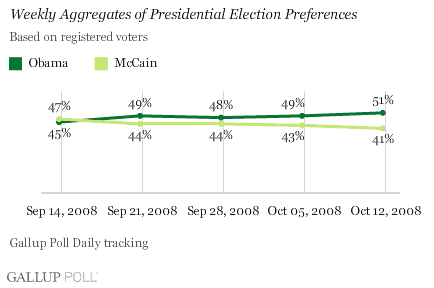
These weekly averages are based on interviews with roughly 6,400 registered voters conducted each Monday through Sunday, compiled from Gallup Poll Daily tracking. These large samples allow for a stable and in-depth look at how voter subgroup preferences have changed.
With only a few exceptions, most voter subgroups have shifted in Obama's direction since mid-September, about the time that the economic crisis came to dominate the news headlines. The following outlines some of the more notable shifts among voter subgroups.
Gender
Women, who had been strong supporters of Obama for much of the campaign, quickly returned to the Democratic fold after they had moved more toward McCain after the Republican convention in early September. Women have supported Obama by an average of 53% to 39% over the last four weeks.
As recently as the week of Sept. 29-Oct. 5, men continued to show a preference for McCain, but in the last week, Obama has gained the lead among men, 49% to 44%. Even with that recent movement among men, the data continue to reflect a gender gap, with women significantly more likely than men to support the Democratic nominee.
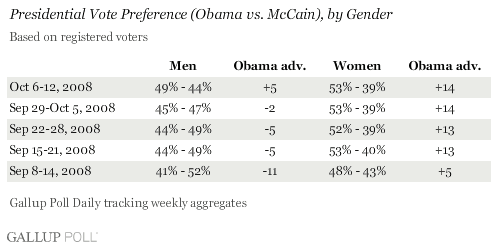
Age
For much of the campaign, it looked like the election would be decided by middle-aged voters -- those between the ages of 30 and 64 -- given younger voters' strong attraction to Obama and older voters' preference for McCain. The two middle-aged groups (aged 30 to 49 and 50 to 64) have both swung from a pro-McCain position after the GOP convention to favoring Obama by a significant margin. During this time, McCain's lead among senior citizens has also evaporated. While Obama has made gains among all age groups, the candidates' relative appeal by age group remains in place.
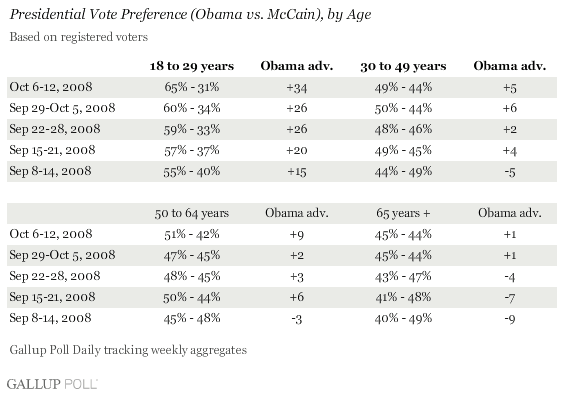
Education
Obama now holds a lead among voters whose support he struggled to attract during the primaries, namely those with less formal education. He now leads McCain 51% to 40% among those with a high school education or less, after trailing McCain by 48% to 41% after the GOP convention. It's possible the economic crisis has made these voters' financial concerns more influential in their vote than possible concerns about Obama's experience.
Obama maintains the high support among postgraduates that has been evident all year, but has erased McCain's advantage among college graduates.
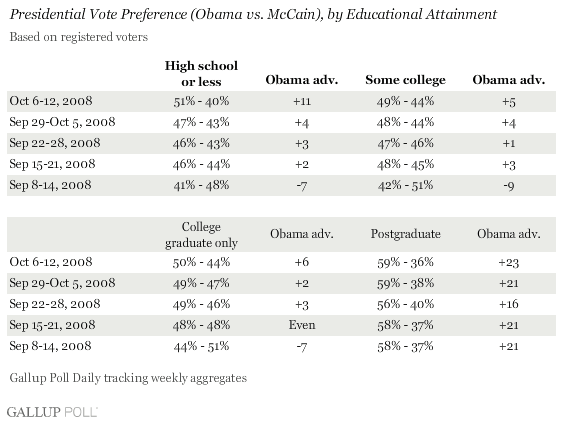
Race
While white voters still prefer McCain to Obama, the gap has shrunk from 18 points to 4. Black voters continue to show overwhelming support for Obama, as they have for other Democratic candidates in the past.
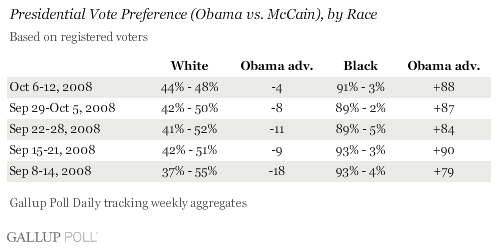
Political Affiliation
For much of the campaign, the election was close despite a significant advantage in Democratic Party identification because Obama failed to command the same level of party loyalty as McCain. Now, Obama receives the same share of the vote from self-identified Democrats (87%) as McCain does from Republicans (87%). Independents, who have been pretty evenly divided between McCain and Obama most of this election year, have swung from a pro-McCain position after the GOP convention (47% to 40%) to a solidly pro-Obama group (49% to 39%) at the current time.
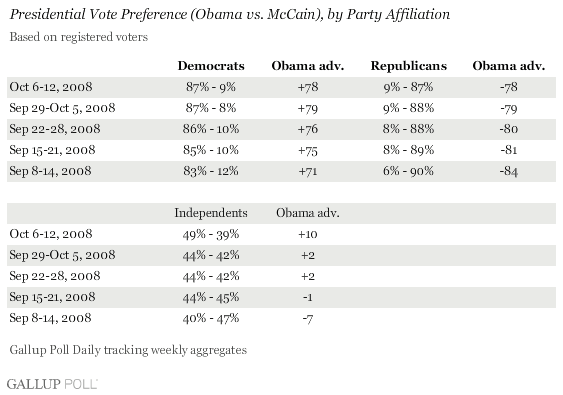
Within party groups, there have been some recent shifts according to voters' ideology. Since mid-September, Obama's support among conservative Democrats has risen from 66% to 78%, while McCain's share of the moderate and liberal Republican vote has fallen from 85% to 77%.
Religiosity
Regular churchgoers are one group that has maintained a solid level of support for McCain over the past several weeks. Obama has made significant gains among those who attend religious services "nearly every week" or "monthly," leading among this group by 52% to 42% compared with a 51% to 43% McCain lead a month ago.
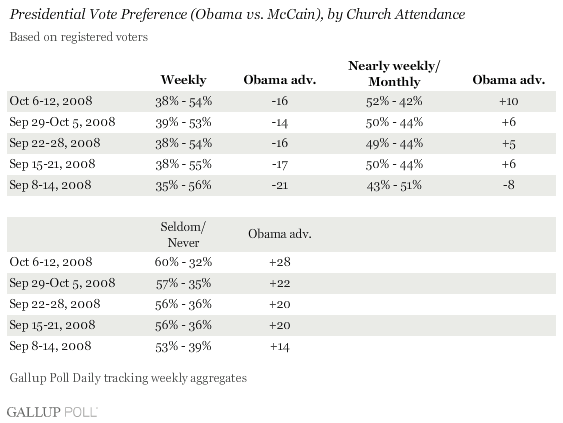
2004 Vote
Perhaps one of the more troubling signs in the data for McCain's electoral prospects is the fact that he is running only even with Obama in states George W. Bush won in 2004. Obama has a commanding 58% to 35% advantage in states John Kerry won.
The most competitive states -- those in which the winning candidate won by 6 points or less in 2004 -- have strongly tilted in Obama's direction in recent weeks. In the Oct. 6-12 data, Obama leads McCain by 55% to 38% among registered voters in these states, compared with just a 4-point Obama lead after the Republican convention (48% to 44%).
McCain's advantage over Obama in "red states" (those Bush won by more than 6 points in 2004) is down to just 48% to 44%, compared to a 56% to 37% McCain lead after the Republican convention. Meanwhile, Obama enjoys a 21-point edge over McCain among residents of states Kerry won by more than 6 points in 2004, 57% to 36%.
Implications
Obama's surge in the polls in recent weeks has been fairly broad-based across demographic and political subgroups of the electorate, but he has made particularly notable gains among men, those with less formal education, and middle-aged voters. These groups have tended to lean in McCain's direction or be about even, so it is clear that the movement is a bad sign for the McCain campaign.
The data reviewed here are based on weekly aggregates of very large samples, the latest of which is based on Oct. 6-12 interviewing. In the last few days of Gallup Poll Daily tracking, including Oct. 13-14 interviewing, Obama has maintained a lead, though not quite as large as it has been for much of the prior week. So to some extent, McCain may be winning back some of the voters who have moved into the Obama camp in recent weeks, but the Republican nominee still has a lot more work to do in order to mount the big comeback he needs to prevail on Election Day.
Survey Methods
Results are based on telephone interviews with 6,468 registered voters, aged 18 and older, conducted as part of Gallup Poll Daily tracking Oct. 6-12, 2008. For results based on the total sample of registered voters, one can say with 95% confidence that the maximum margin of sampling error is ±1 percentage point.
Interviews are conducted with respondents on land-line telephones (for respondents with a land-line telephone) and cellular phones (for respondents who are cell-phone only).
In addition to sampling error, question wording and practical difficulties in conducting surveys can introduce error or bias into the findings of public opinion polls.
